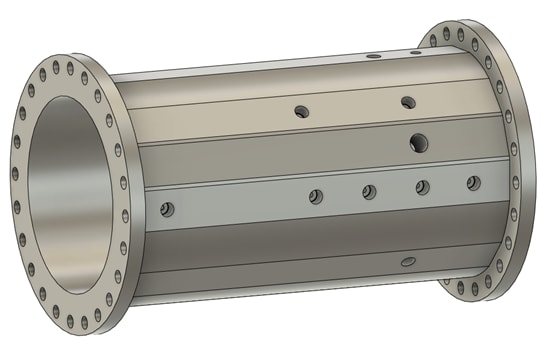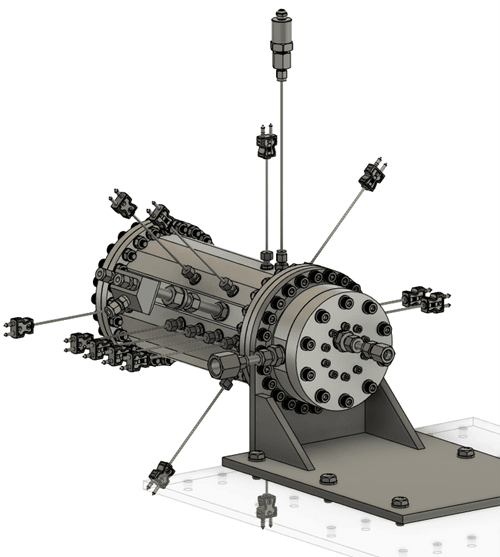GU Rocketry's First Liquid Bipropellant Rocket Engine - Helios
Follow articleHow do you feel about this article? Help us to provide better content for you.
Thank you! Your feedback has been received.
There was a problem submitting your feedback, please try again later.
What do you think of this article?
Overview
GU Rocketry’s Propulsion Team consists of 20 engineers and physicists designing, developing and testing SRAD engines. The team competes at the annual Race to Space competition held at the Westcott Space Cluster. This year, the team is pivoting to liquid bi-propellant engines, utilising liquid oxygen (LOX) and isopropyl alcohol (IPA) as propellants.
The team have previously developed and tested Chimera, a 500N hybrid engine running on N2O and HDPE. Chimera was successfully hot-fired at R2S 2023. Chimera provided the team with a vast amount of experience regarding rocket engine design, leading the team to enter a 9-month development timeline for Helios, our current project.
Objectives
Helios is designed to produce 1,000N of thrust across a burn time of 5 seconds. Being the first liquid bi-prop engine developed by GU Rocketry, the teams hope to extract as much data as possible during the hot fire. Helios is designed to accommodate 14 thermocouples, responsible for recording wall and combustion temperatures at different engine locations. There will also be a pressure sensor, responsible for recording the pressures reached inside the combustion chamber. The combination of such sensors will allow the team to identify any combustion instabilities and what may have caused them.
As this is GU Rocketry’s first liquid bi-prop engine, the team made the decision to prioritise a successful test over performance. This has led to components being designed to excessive factors of safety, and a heat-sink design. The heat sink design is responsible for absorbing the heat from the combustion and dispersing it amongst the body of the engine.
Pintle Injector
Helios features a pintle injector as the propellent injection method. The below diagram depicts the flow directions of both the oxidiser and fuel. The fuel and oxidiser meet at the impinging point, producing small particles of propellants that are redirected into a conical shape.
The pintle injector is a key component of the engine with very small margins of error. If the pintle tip is slightly off-centre, then the propellants will be unevenly sprayed along one side of the engine, which may be catastrophic. 8 of the 14 thermocouples are responsible for recording any hot spots produced by uneven propellent mixing produced by the injector.
Combustion Chamber
The combustion chamber, often referred to as the heart of the engine, was developed using a program called Rocket Propulsion Analysis (RPA). The combustion chamber has a wall thickness of 20mm, far thicker than what it needs to be to withstand the stresses from the combustion. The reason for the thick wall is to absorb as much of the heat from combustion as possible, hence, a ‘heat-sink’ design.
The combustion chamber is responsible for attaching to all other parts of the engine, attaching to the engine mount, injector, and nozzle. The chamber will be manufactured out of one piece of grade 304 stainless steel, due to the availability, cost, and adequate thermal and mechanical properties.
Nozzle
The nozzle is a key part of the engine, responsible for accelerating the supersonic flow after passing through the throat. Helios' nozzle is to be manufactured out of graphite due to the extremely high maximum operating temperature. Helios’ nozzle is responsible for accelerating the exhaust gases to 2072 m/s at the nozzle exit, equivalent to a Mach number of 2.15 at the exit conditions.
The two main types of rocket nozzles are conical and bell. The bell nozzle is typically more efficient, however, for what the team is trying to achieve, a conical nozzle is more than adequate. The team balanced efficiency against ease of manufacturing and it quickly became apparent that a conical nozzle would suffice. Conical nozzles have straight edges, whereas bell nozzles (typically seen on orbital rockets) have a curved wall, as depicted in the comparison below.
Assembly
The assembly of Helios, seen below, consist of the previously mentioned parts, as well as numerous bolts, washers, sensors, and gaskets in order to ensure the engine performs as expected. All modelling, FEA and assembly was completed in Fusion 360.
To ensure all the gaskets on the engine produce an adequate seal, numerous torquing calculations were completed in order to ensure each individual bolt is torqued correctly. During the design stage, certain bolts had to be increased in size to avoid breaking the bolt prior to a seal being produced. Such an issue is one of many that was encountered throughout the development of Helios, amplifying the need for rigorous and thorough design reviews.
Next Steps
As GU Rocketry closes out the development of Helios, the team is discussing the future plan of action to align with the long-term goals of the society. A 10-year goal of GU Rocketry is to launch SRAD liquid engines on a regular basis. To do this, the team must have a fully developed flight-weight engine and feed system. The coming years for the propulsion department will see cooling, feed system and flight-weight design all be incorporated into our test engines, with an engine being integrated into an airframe in the not-so-distant future.
To reach these goals, the Propulsion Team will aim to annually compete at the Race to Space competition (https://www.racetospace.org.uk/). The experience, knowledge, and facilities provided are extremely beneficial to the team and will undoubtedly improve our chances of meeting our long-term goals.






